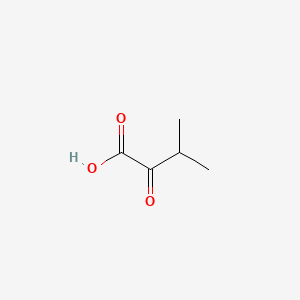| MeSH term | MeSH ID | Detail |
|---|---|---|
| Uremia | D014511 | 33 associated lipids |
| Kidney Failure, Chronic | D007676 | 51 associated lipids |
| Diabetes Mellitus | D003920 | 90 associated lipids |
| Ketosis | D007662 | 13 associated lipids |
| Body Weight | D001835 | 333 associated lipids |
| Carbon Tetrachloride Poisoning | D002252 | 12 associated lipids |
| Coronary Disease | D003327 | 70 associated lipids |
| Prostatic Neoplasms | D011471 | 126 associated lipids |
| Weight Gain | D015430 | 101 associated lipids |
| Glioma | D005910 | 112 associated lipids |
3-Methyl-2-oxobutanoic acid
3-Methyl-2-oxobutanoic acid is a lipid of Fatty Acyls (FA) class. 3-methyl-2-oxobutanoic acid is associated with abnormalities such as Maple Syrup Urine Disease and Kidney Failure, Chronic. The involved functions are known as Phosphorylation, Citric Acid Cycle, inhibitors, Process and Metabolic Control. 3-methyl-2-oxobutanoic acid often locates in Mitochondria, BL21, Cytoplasm, Ribosomes and Head. The associated genes with 3-Methyl-2-oxobutanoic acid are Genome, Homologous Gene, Operon, Alleles and Oxidoreductase Gene. The related lipids are dimyristoylphosphatidylglycerol, 9-oxononanoic acid, Valerates and alpha-ketocaproic acid.
Cross Reference
Introduction
To understand associated biological information of 3-Methyl-2-oxobutanoic acid, we collected biological information of abnormalities, associated pathways, cellular/molecular locations, biological functions, related genes/proteins, lipids and common seen animal/experimental models with organized paragraphs from literatures.
What diseases are associated with 3-Methyl-2-oxobutanoic acid?
3-Methyl-2-oxobutanoic acid is suspected in Maple Syrup Urine Disease, Kidney Failure, Chronic and other diseases in descending order of the highest number of associated sentences.
Related references are mostly published in these journals:
| Disease | Cross reference | Weighted score | Related literature |
|---|
Possible diseases from mapped MeSH terms on references
We collected disease MeSH terms mapped to the references associated with 3-Methyl-2-oxobutanoic acid
PubChem Associated disorders and diseases
What pathways are associated with 3-Methyl-2-oxobutanoic acid
There are no associated biomedical information in the current reference collection.
PubChem Biomolecular Interactions and Pathways
Link to PubChem Biomolecular Interactions and PathwaysWhat cellular locations are associated with 3-Methyl-2-oxobutanoic acid?
Visualization in cellular structure
Associated locations are in red color. Not associated locations are in black.
Related references are published most in these journals:
| Location | Cross reference | Weighted score | Related literatures |
|---|
What functions are associated with 3-Methyl-2-oxobutanoic acid?
Related references are published most in these journals:
| Function | Cross reference | Weighted score | Related literatures |
|---|
What lipids are associated with 3-Methyl-2-oxobutanoic acid?
Related references are published most in these journals:
| Lipid concept | Cross reference | Weighted score | Related literatures |
|---|
What genes are associated with 3-Methyl-2-oxobutanoic acid?
Related references are published most in these journals:
| Gene | Cross reference | Weighted score | Related literatures |
|---|
What common seen animal models are associated with 3-Methyl-2-oxobutanoic acid?
There are no associated biomedical information in the current reference collection.
NCBI Entrez Crosslinks
All references with 3-Methyl-2-oxobutanoic acid
Download all related citations| Authors | Title | Published | Journal | PubMed Link |
|---|---|---|---|---|
| Savrasova EA et al. | Use of the valine biosynthetic pathway to convert glucose into isobutanol. | 2011 | J. Ind. Microbiol. Biotechnol. | pmid:21161324 |
| Li S et al. | Engineering Bacillus subtilis for isobutanol production by heterologous Ehrlich pathway construction and the biosynthetic 2-ketoisovalerate precursor pathway overexpression. | 2011 | Appl. Microbiol. Biotechnol. | pmid:21533914 |
| Gong L et al. | Characterization of organic anion-transporting polypeptide (Oatp) 1a1 and 1a4 null mice reveals altered transport function and urinary metabolomic profiles. | 2011 | Toxicol. Sci. | pmid:21561886 |
| de Graaf RM et al. | The organellar genome and metabolic potential of the hydrogen-producing mitochondrion of Nyctotherus ovalis. | 2011 | Mol. Biol. Evol. | pmid:21378103 |
| Hirani TA et al. | Asp295 stabilizes the active-site loop structure of pyruvate dehydrogenase, facilitating phosphorylation of ser292 by pyruvate dehydrogenase-kinase. | 2011 | Enzyme Res | pmid:21318135 |
| Li JV et al. | Metabonomic investigation of single and multiple strain Trypanosoma brucei brucei infections. | 2011 | Am. J. Trop. Med. Hyg. | pmid:21212208 |
| de Kraker JW and Gershenzon J | From amino acid to glucosinolate biosynthesis: protein sequence changes in the evolution of methylthioalkylmalate synthase in Arabidopsis. | 2011 | Plant Cell | pmid:21205930 |
| Park HD et al. | Three Korean patients with maple syrup urine disease: four novel mutations in the BCKDHA gene. | 2011 | Ann. Clin. Lab. Sci. | pmid:21844576 |
| Mescka C et al. | In vivo neuroprotective effect of L-carnitine against oxidative stress in maple syrup urine disease. | 2011 | Metab Brain Dis | pmid:21380499 |
| Sakuragi H et al. | Molecular breeding of advanced microorganisms for biofuel production. | 2011 | J. Biomed. Biotechnol. | pmid:21318120 |
